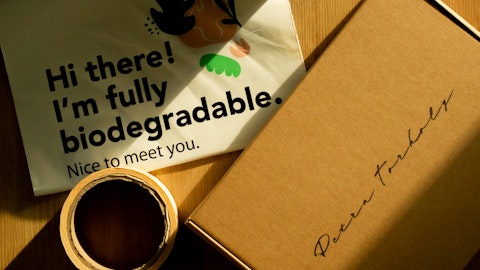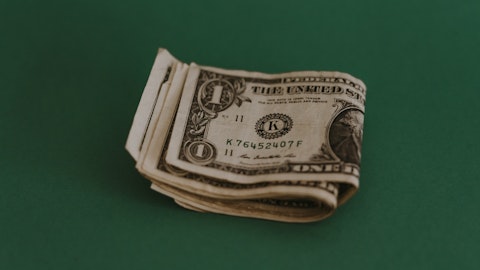Michael Roxland: Just quickly, as Jackson started and running obviously it seems to be meeting or exceeding expectations, have you adjusted your operating posture elsewhere just to account for the demand environment? And then just my last question is with inputs coming off, as you noted, have you seen any change in behavior from any of your competitors with respect to downtime or production discipline?
Mark Kowlzan: I’m not going to talk about our competitors. We just — we’re running to demand. We’ll continue to run to demand. The Jackson machine is an opportunity for us to provide low-cost, high-quality containerboard into that Southeastern region. But it also means, as you could well assume, the rest of the system will run as we need to run it. But keeping in mind what I just said that we have our big annual outages coming at our 2 biggest mills being DeRidder and Counce, Tennessee, so our plans were to run a little bit extra inventory build over the next couple of months to ensure that as we go through these big outages, we will supply our needs appropriately.
Michael Roxland: Got it. I’ll turn it over. Good luck in the balance of the year.
Operator: And our next question comes from Mark Weintraub from Seaport Research Partners.
Mark Weintraub: Following up on George’s question to some extent. You had talked about how the capital projects really helped on the and capital, particularly the converting operations. You’ve also talked about how your price mix was really strong in the fourth quarter. And frankly, it’s been really good for the last like 2 years. You’ve just been doing extraordinarily well, price/mix. How the capital projects help to improve your — the mix in terms of like more higher value-added packaging that you’re providing your customers? Or has your extraordinary performance been kind of just execution also your focus on smaller, more local accounts.
Thomas Hassfurther: Mark, this is Tom. I’ll handle that. I mean, keep in mind that we’ve always said that our customers drive what we do and especially in the box plants, they drive our capital investments. So we grow with them, and we adapt to whatever they need and what they’re looking at, and we try to align ourselves with customers that are going to grow going forward, whether they’re small or large. So I think that all of that kind of comes together. And our objectives are not only from a cost standpoint, but to satisfy those customers and puts us in a good position, I think, to take advantage of whatever the market opportunities present.
Mark Weintraub: And so sort of getting to the next — so would you say that the product that you’re producing and selling to the customer has changed much? Or it’s really — so the mix has sweetened that way over the last couple of years? Or it’s just you’ve been very, very successful in getting higher pricing?
Thomas Hassfurther: Well, I’ll give you an example. Our customers are continually having to change to be successful in the marketplace. And if you look at the retail market, as an example, it’s very different today than what it was even 5 years ago. And during COVID, a lot of things occurred, especially inside the big box stores as an example. How do we get the customer back in there? What are they buying? What are they looking for? How do I promote my products and things like that. So there’s been a lot of changes, and we assist a lot of our customers in helping make those changes and keeping track of what those trends are.
Mark Weintraub: Okay. Great. And then lastly, obviously, demand kind of — to me at least, it’s been astoundingly weak in the last couple of quarters. And you’ve pointed out the various drivers. Do you have any sense as to how impactful in particular, say, the inventory correction has been in terms of the magnitude of decreases? And are you getting any clarity from customers where we might be in that process? Because it sounds like we’re going to continue to see weakness in the first quarter at a minimum. And then a tough question, but are you getting any indications from your customers as to what to expect for the full year? Or is it just not enough visibility?
Thomas Hassfurther: Okay. Let me tackle a couple of these at a time. I think, first of all, let’s see if we can help get ourselves calibrated here properly. We’re coming out of COVID now, which had a tremendous amount of government stimulus pumped into a market which created, in my opinion, quite a bubble in terms of demand. If you look back historically and you look at box demand historically, it was always pretty level at that 1% to 2% range per year. And all of a sudden, we’re jumping up into now double digits and some other things during the COVID years. So that’s why I drew the correlation with what happened in — how we compare now to 2019 and being 6% or maybe slightly above 6% compared to 2019 being up, clearly, some of the errors come out of that bubble, but not all by any means.
So it’s still a quite healthy demand, in my opinion, when you compare it to pre-COVID. And relative to the inventory correction. Yes, there was a huge inventory correction, and that’s still continuing to some extent, as a combination of 2 things. Still, the supply chain is a big issue for our customers. And as you know, China just recently reopened. So there is still an enormous backlog of products waiting to be shipped and just waiting for parts whether it’s in the auto sector or any other consumer product sector. There’s quite a big backlog. So we’re still waiting for that to correct. I thought it would have been corrected a little bit sooner than what it appears. And that’s why we’re taking a relatively conservative approach to our forecast for the first quarter because we really can’t predict when that’s going to catch up to some extent.
But I would say overall, our customers feel pretty good about where they are and about the full year, if we may have a mild recession, we hopefully have a soft landing, those sorts of things. And hopefully, the Fed backs off a little bit on the interest rate increases. Those are all, I think, important to our success in ’23, and we’ll just have to wait and see what happens. But overall, I think when you really compare it to pre-COVID, we’re still in a pretty healthy position.
Operator: And our next question comes from Adam Josephson from KeyBanc Capital Markets.
Adam Josephson: Hope you’re well. Mark, one more on the conversion delay. When did you arrive at that decision, and why — you mentioned you’re postponing the second phase by year. Why a year as opposed to, I don’t know, 6 months, 9 months, 15 months or just indefinitely and whenever demand gets better, we’ll do it as opposed to we’re planning to do it a year from now.
Mark Kowlzan: Adam, if demand picked up next month and all of a sudden, we needed the tons, we could pull the plug on that project, and we could do it in the spring time if we wanted to. That’s the luxury that we have. We have all the equipment in our hands sitting in the warehouse at the mill. We have all the engineering done. So when we need the tons, we will do that project, and that’s the benefit that we have there. So there’s no secret formula. There’s no magic in terms of what’s driving this decision except the marketplace and our customers. And as Tom mentioned a few minutes ago, we grow with our customers’ demands, and we’re in a good place to do that, but also being mindful of our uses of cash and our capital spending, there’s no need to spend the remaining portion of that capital on a project that’s not earning any return currently as opposed to perhaps another use of that cash this year.





